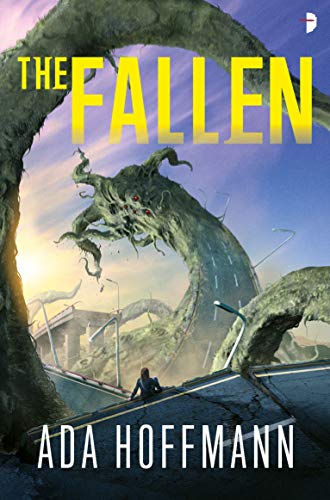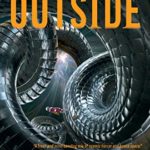
As the second book in Ada Hoffman’s The Outside series, The Fallen picks up where The Outside left off but is less concerned with a continuing adventure than with deep probing of all the major characters. There is plenty of action as well, but I was totally absorbed in understanding the minds and backgrounds of the extraordinary people who were deeply affected by the extradimensional force known as the Outside.
You can read The Fallen for its own intrinsic interest, but naturally it becomes all the more resonant if you first read The Outside. Here is a little background, keeping spoilers for the first novel to a minimum.
The Fallen takes place after Yasira’s entering the Outside and transforming a fifth of the surface of the planet Jai. By doing that, she splintered herself, created a Chaos Zone where reality is unpredictable but also helped a third of the residents to acquire limited special powers of their own that help make the transformed planet more livable. The Angels, those surgically transformed humans who serve the ruling AI gods of this universe, clamp down on any manifestation of Outside power as heresy. They claim to protect the people of Jai but do so by severely limiting the food, water and tools they can use, keeping them totally subservient.
We encounter an exhausted and immobilized Yasira at the outset of The Fallen. Her mind and personality broke under the pressure of the Outside, which so infused her being that she split apart. She thinks of her inner selves as a Strike Force, unable to act because her many voices are always arguing and cannot agree. Deep in depression, she spends most of her time isolated in her bed, hardly able to move, certainly not able to make use of her power over the Outside. This is very much a story of her healing.
She is protected by her lover Tiv and a team of seven others, each of whom has a special power. The Seven are all former students of Eviana Talirr, who first explored the mysteries of the Outside and has since disappeared. Tiv, who was shielded from the Outside by Yasira, is acknowledged as the Leader of the group. She organizes their activities and sends the Seven out in teams to help communities in the Chaos Zone, who are always in need of food, medicine or other forms of support.
They regard Yasira as their Savior, a figure of hope who will one day, they believe, help free them from the Angels and restore the livability of the Chaos Zone. Akavi, the angel charged with capturing Yasira as a heretic in The Outside, failed her mission and is now on the run from her AI overlords. Though hunted by other angels, she tries to infiltrate the Seven and turn them against each other so she can capture Yasira and regain her former position.
In the afterward to The Fallen, Ada Hoffman explains how psychological plurality became a key interest in this series, and that emerges as a powerful central theme of the story. She explores plurality and neurodivergence in many forms. To begin with there is Yasira with her Strike Force of many selves. Sometimes they argue about how bad she is, at other times about what she should do with herself. The question she struggles with is how to bring her selves together so that she can help all the people in the Chaos Zone.
Then there are Tiv and the Seven, all working as a found community to protect Yasira and to help the scattered communities of Jai. Within that group are Four who complement each other, communing to complete themselves, as if they comprised different aspects of one mind.
Quite different are the Gone people who were so distorted by the impact of the Chaos Zone that they gave up individuality altogether. They have achieved a hive mind. They don’t speak and carry out bloody, piercing rituals but are capable of group action that can change and improve the world twisted by the Outside. Yasira feels kinship with them because they became a complex mind of many selves not by fragmenting, as she did, but by the opposite of having injured individuals reach out and find each other.
For the Gone people, language is unnecessary. They communicate by picturing what they need to do and then by all acting together to get it done. Yasira knows that her task is to protect them with her special power yet before she can do that she must learn to communicate with them through the same process of mental picturing.
In a sense, Akavi, the fallen angel who still pursues Yasira, presents another form of plurality for purely manipulative purposes. She changes bodies and personalities to win people over only to betray them.
The Fallen is exceptional for the second book in a series in its shift of tone and pace. It becomes much more of a character study, with personal histories of the main characters and detailed attention to what it’s like to live with the impact of trauma and with a divided self that immobilizes the self (selves). But it also dramatizes how division can be overcome to achieve a powerful collective action,.
In structure, it gradually links up earlier timelines in characters’ development with the present where Yasira, Tiv and the Seven are trying to improve life on Jai. First they help individuals and communities, but then undertake alterations to the Outside through mass action. The story is complicated to follow at times since there are many scenes of action and many character arcs to follow. But Hoffman brings this off beautifully in an intense reading experience.
The Outside as a series seems less preoccupied with spinning out an adventurous plot than exploring the realities, within people’s minds and outside them, and how they can splinter, twist and transform into something different. This second novel builds on the rich background of The Outside but provides everything a reader needs to understand what’s going on. The Fallen examines the characters and the world of Jai they have changed from a more inward perspective but develops in its own exciting direction. Though it feels very much part of an ongoing series, The Fallen provides all the richness of an independent novel.





Leave a Reply